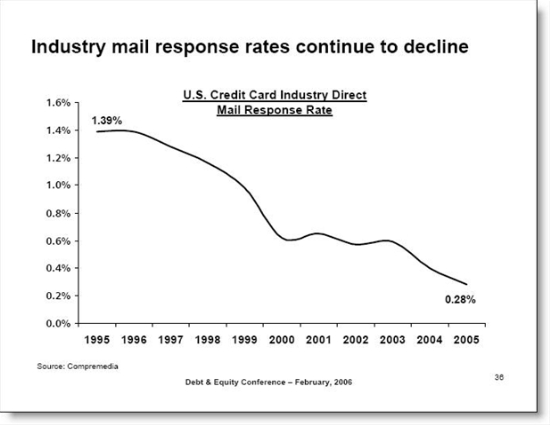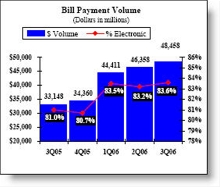 Advertising-monitoring firm, Mintel Comperemedia reported last week that nearly 9 out of 10 credit card solicitations in 2006 directed recipients to the Web, up sharply from 56% in 2003 (see note 1, 2). Several big mailers, namely American Express, still seem reluctant to use website response as an option, at least in the mailers we see at our house.
Advertising-monitoring firm, Mintel Comperemedia reported last week that nearly 9 out of 10 credit card solicitations in 2006 directed recipients to the Web, up sharply from 56% in 2003 (see note 1, 2). Several big mailers, namely American Express, still seem reluctant to use website response as an option, at least in the mailers we see at our house.
American Express tests must show a drop in response by offering too many choices. But if you don't have the budget of American Express, which can afford to drop a mail piece in every credit-worthy household every two or three weeks, you should add website options to your direct mail creative. That way, you can at least capture a lead at your website, even if they don't ultimately accept your credit offer.
Total mailing volume for 2006 was 9.2 billion pieces (see note 1), or about 3 per week per credit-worthy household. Two of those were from the five largest mailers listed below which accounted for more than 60% of the volume, according to Comperemedia. JPMorgan Chase accounted for 18% on its own.
In another data slice from Comperemedia, cited by Capital One in a Feb. 2006 investor presentation (PDF here), response rates have fallen from 1.4% in 1995 to 0.3% in 2004 (see note 3).
Here's a breakdown of the billion-piece club, and their percent change compared to 2005:
1. Chase >>> 1.7 billion (down 4%)
2. Capital One >>> 1.2 billion (up 13%)
3. American Express >>> 1 billion
4. Citibank >>> 980 million (down 2%)
5. Bank of America/MBNA >>> 920 million (down 17%)
Other top-10 mailers: HSBC (up 25%); Discover (up 29%); Barclays Bank (190 million, up 70%)
Note:
1. Comperemedia tracks mailing volume for more than 150 large financial institutions. So the figures here do not include mailings from thousands of smaller banks and credit unions. In total, those probably account for less than 5% of the total from the top-150.
2. Comperemedia press release is here. Interview of Comperemedia director Jenny Roock by MediaPost is here.
3. Credit card response rate slide from Capital One's investor presentation (PDF) at the Debt & Equity Conference, Feb. 2006; data from Comperemedia.












